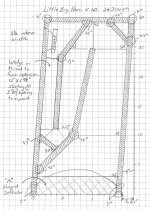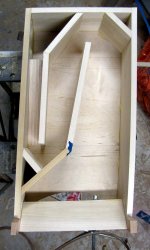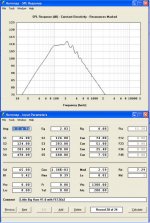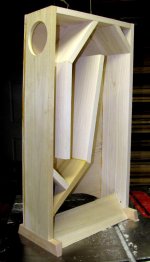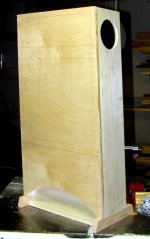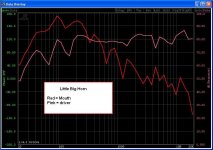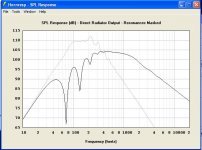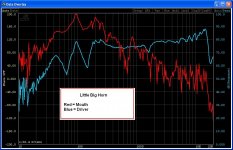So I show my wife my Bugelhorns and she says they are nice and small (compared to some of my other speakers) but they are still a little too big to allow into the civilized living space.
Little Big Horn is my attempt to squeeze into a 25% smaller volume, roughly equivalent to a Frugelhorn. The mouth vents to sides at the floor. This avoids one major bend where the cross section is nearly at its widest and makes the folding easier and more space efficient.
The other significant feature is that the box is tilted back 4 degrees. This will bring the sound stage up to ear level at a reasonable listening distance even though it is only 30" tall.
It is designed for the FE126E but I used measured Theil Small Parameters instead of Fostex published values. The FE126E you receive is quite different from the published specs. Fs in particular is significantly higher.
Here is the drawing.
Little Big Horn is my attempt to squeeze into a 25% smaller volume, roughly equivalent to a Frugelhorn. The mouth vents to sides at the floor. This avoids one major bend where the cross section is nearly at its widest and makes the folding easier and more space efficient.
The other significant feature is that the box is tilted back 4 degrees. This will bring the sound stage up to ear level at a reasonable listening distance even though it is only 30" tall.
It is designed for the FE126E but I used measured Theil Small Parameters instead of Fostex published values. The FE126E you receive is quite different from the published specs. Fs in particular is significantly higher.
Here is the drawing.
Attachments
Absolutely stunning. I love the swept-back profile and the platform / mouth. I think you definitely win the award of world's fastest BLH designer and builder (!)
Just a newbie question but on the folding scheme, does the expansion actually narrow a tad near the area (on the diagram) where "35" appears twice?
Really sharp work!
Just a newbie question but on the folding scheme, does the expansion actually narrow a tad near the area (on the diagram) where "35" appears twice?
Really sharp work!
rjbond3rd - You're right. It does skinny down a little bit there. It's one of the compromises I made to fit it in the box. Based on some measurements I've made at the mouth, it doesn't seem to have hurt.
Speaking of which, I've attached some measurements I've made at the mouth and also right in front of the driver. It looks pretty much like hornresp said it would (next post).
Speaking of which, I've attached some measurements I've made at the mouth and also right in front of the driver. It looks pretty much like hornresp said it would (next post).
Attachments
So how do they sound? I've listened a while now in one channel stereo (I only have the one built). They sound very similar to my bugelhorn with the FE126E driver, which is what I was shooting for; the same sound in a smaller package.
rjbond3rd and loninappleton - Thanks for the complements. I'm happy with the way the look turned out. I think it has a little Art Deco feel with the swept back look and arch over the deflector. Now all I have to do is finish the second one and then veneer them both.
rjbond3rd and loninappleton - Thanks for the complements. I'm happy with the way the look turned out. I think it has a little Art Deco feel with the swept back look and arch over the deflector. Now all I have to do is finish the second one and then veneer them both.
Construction Details
Like my Bugelhorns, the sides are made of Poplar Plywood and the partitions are made of solid Poplar 1 X 6" boards (actually 3/4 X 5 1/2").
There is a wedge in the throat to square it up. This time, I made the wedge out of four pieces of 12mm plywood. That's how I came up with the odd 1 7/8" dimension of the wedge. 94 X 12mm ~ 1 7/8")
The back side of the driver hole is routed with a 1/2" roundover bit to give the driver more "breathing room".
The horizontal outrigger boards on the front and back bottom edged are attached using pocket hole screws. These provide an incredibly strong joint between the end grain of the front and back and the edge grain of the outriggers.
I'm probably going to add a support board in the mouth. I noticed moderate vibrations of the sides without it.
It's a pretty simple layout with the 4 degree tilt adding a certain amount of fussiness to the build (it's amazing how many different ways you can cut 4 degrees wrong). If you gave up on the tilt and just made the edges vertical it would be a very easy speaker to build.
Like my Bugelhorns, the sides are made of Poplar Plywood and the partitions are made of solid Poplar 1 X 6" boards (actually 3/4 X 5 1/2").
There is a wedge in the throat to square it up. This time, I made the wedge out of four pieces of 12mm plywood. That's how I came up with the odd 1 7/8" dimension of the wedge. 94 X 12mm ~ 1 7/8")
The back side of the driver hole is routed with a 1/2" roundover bit to give the driver more "breathing room".
The horizontal outrigger boards on the front and back bottom edged are attached using pocket hole screws. These provide an incredibly strong joint between the end grain of the front and back and the edge grain of the outriggers.
I'm probably going to add a support board in the mouth. I noticed moderate vibrations of the sides without it.
It's a pretty simple layout with the 4 degree tilt adding a certain amount of fussiness to the build (it's amazing how many different ways you can cut 4 degrees wrong). If you gave up on the tilt and just made the edges vertical it would be a very easy speaker to build.
chuyler1 said:Man you are fast to build these things! These ones should be real lookers once you are finished.
yup, sometimes it takes longer to draw the damn things out than to blast the raw boxes together
of course the finishing for full WAF can take several days longer
chrisb said:
yup, sometimes it takes longer to draw the damn things out than to blast the raw boxes together
of course the finishing for full WAF can take several days longer
You got that right. I built the one speaker in a day and a half but it will probably take a week or more to build the second one and veneer them both.
DOH!
I've been posting measurements to this thread and my Bugelhorn thread from my Smith and Larson Speaker Tester setup and they have been pretty low resolution (1/3 Octave). I just figured out it's capable of MUCH higher resolution. Live and learn.
Here is a new measurement at the mouth and directly in front of the driver at ten times the resolution. In comparing this to the hornresp simulation in post #9, I can match up most of the characteristic bumps and valleys. The one big exception is the mouth measurement peak at 100hz. I'm at a loss to explain it and I'm not even sure if it's real or a room artifact of some kind. The mic was placed literally at the opening of the mouth and the speaker was placed away from any walls. I moved it to another spot in the room and got the same response. The weather is not cooperating so outside measurements are out for now.
I don't know how closely the measurements should match because I can't say I've ever seen similar measurements of a horn. Can anyone hazard a guess at what it it is? I'm going to try the same measurements with my Bugelhorn but it's going to take a little while to get one back together with an FE126E.
I've been posting measurements to this thread and my Bugelhorn thread from my Smith and Larson Speaker Tester setup and they have been pretty low resolution (1/3 Octave). I just figured out it's capable of MUCH higher resolution. Live and learn.
Here is a new measurement at the mouth and directly in front of the driver at ten times the resolution. In comparing this to the hornresp simulation in post #9, I can match up most of the characteristic bumps and valleys. The one big exception is the mouth measurement peak at 100hz. I'm at a loss to explain it and I'm not even sure if it's real or a room artifact of some kind. The mic was placed literally at the opening of the mouth and the speaker was placed away from any walls. I moved it to another spot in the room and got the same response. The weather is not cooperating so outside measurements are out for now.
I don't know how closely the measurements should match because I can't say I've ever seen similar measurements of a horn. Can anyone hazard a guess at what it it is? I'm going to try the same measurements with my Bugelhorn but it's going to take a little while to get one back together with an FE126E.
AndrewL said:Could it be the Floor reflections? The presence of the floor would make the mouth seem bigger. Does hornresp take into account the floor?
-- Andrew
It does from the point of view of simulating corner loading. The mic is only about 3" off the floor and I have the floor deflector to try to prevent sound from bouncing back up into the horn. You raise an interesting point in that one thing I can try is raising the speaker off the floor and repeating the measurement. I'm not sure what the effect could be but it's easy enough to try.
- Status
- This old topic is closed. If you want to reopen this topic, contact a moderator using the "Report Post" button.
- Home
- Loudspeakers
- Full Range
- Little Big Horn
